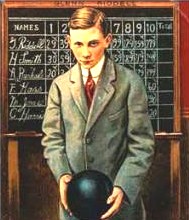
Foul Line
What is the Foul Line?
The foul line of a bowling lane can be found at the very start of the lane, painted across the boards of the lane and sitting between the two gutters.
The purpose of the foul line is to indicate when a bowler has gone too far with their approach and has, in essence, fouled. A foul occurs when the bowling crosses the foul line.
In order to foul any physical part of the bowler, usually, a foot must physically touch the floorboards past the foul line.
There are usually sensors connected to the foul line that are then triggered to either make lights flash or make a series of alarms sound, startling everyone on your lane.
Channels
What Are Gutters in Bowling?
On each side of the bowling lane sits a gutter, a dipped trench that is usually made out of rubber or plastic.
The gutters are 60 feet long as well. When a bowling ball goes off the wooden part of the lane it falls into the gutter and is considered a miss for that throw, resulting in no points added to the current score.
Many groans of frustration and bargaining prayers have been uttered due to gutters, yet for some reason, most of them go unheard.
Head Pin
What Is the Head Pin in Bowling?
The head pin, also called the “one pin” or “pin one”, sits at the very front of the pyramid formation of pins exactly 60 feet from the foul line. Used as a marker for the 60-foot lane the head pin signals where the lane ends and the bowling wall begins.
Approach Area
The Approach Area
The approach area is a wooden area that is 15 feet in length, ending at the foul line. This is the area where bowlers adjust their stance, figure out their timing, and mentally prep before each throw.
Dots located on the wooden boards help bowlers keep track of where they stand in order to adjust their timing with their throws.
The machine where balls come out of after retrieval is also located in this area, back towards the end of the 15 feet and to either the left or right side of the lane to give bowlers plenty of room to pace themselves before a throw.
Lane Markings
Bowling Lane Targeting: Dots, Arrows and Range Markers
If you look down onto the lane you will notice a variety of dots, arrows and range markers decorating the wooden planks at varying distances.
These markings are there to help bowlers with their targeting. Each bowler bowls in a different way.
Their posture or stance could be different, the way the throw could change their trajectory or the timing of their release can shift their ball. This is where the markings come in.
By using these markings bowlers are able to find the basic range in where they want to throw their ball to get it on the right trajectory.
By watching either one or two sets of targets and how the ball rolls by them bowlers are able to make adjustments and alignments based off the results of their throws.
This helps immensely when bowlers are traveling to unfamiliar lanes and are able to use the dots to find their basic range before modifying their alignment as needed.
Types of Targeting Marks
As we mentioned before, there are three basic types of markings found on each lane, dots, arrows and ranger markers. These symbols are spread apart to help with targeting and can be found in different areas of the lane.
Approach Dots
These dots are not actually found on the lane but rather in 15-foot long Approach area just before the lane.
There are three different sets of dots in the Approach area and they are usually 5 or 7 dots wide.
In the center you will always find a dot bigger than the others, this dot is always placed on board number 20 and will line up with the center of the lane and the head pin.
These sets of dots are placed in this manner to help bowlers have a reference point for where to place their feet for their chosen stance.
This is incredibly important since the starting point of the bowler as well as their stance affects the starting angle of the ball.
Lane Dots
While lane dots can vary from bowling alley to bowling alley they are generally found just before the foul line. Sometimes two sets of 5 dots, one from the left and one from the right, can also be found just across the foul line.
The gaps between the sets of dots can also be used as a reference point. These lane dots are used like all the other markings, as reference guides for trajectory and alignment.
Arrows
These arrow-shaped markings are found at the 15-foot mark of the lane in an upside down ‘V’ formation, with the foremost arrow sitting at the center and the closest arrows being at the very edges of the ‘V’.
Many bowlers like to aim between the center arrow and it’s side counterparts in hopes of their trajectory resulting in a strike.
Just after the center arrow the pinewood section of the lane begins, it’s a subtle change in color also used as a marking by bowlers. Because of these factors, the arrows are the most commonly used targeting markings in bowling.
Range Markers
The range markers are actually darkened boards that are located further down the lane and close to the pins. While these boards are considered the ‘main’ target markers, not many bowlers take advantage of their use.
Educate your way into the secrets of your sport,
And practice the artistry of your sport.
Knowledge hidden within secrets raises the level of contentment within your life.
